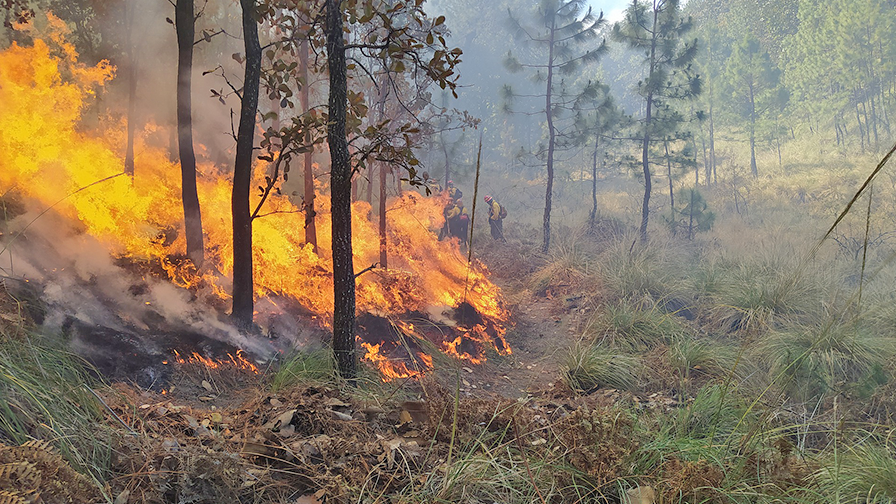- Vegetation Management Services
- In Your Neighborhood
- About
- Careers
- Webinars
- Articles
Putting a Wildland Fire Safety Plan in Place

Putting a Wildland Fire Safety Plan in Place
By Bob Urban, senior manager, ACRT Services
The history and prevalence of wildland fires have never been more timely topics than they are today. These fires — which can ignite because of lightning strikes, human error, and escaped prescribed burns — now number in the tens of thousands across the country each year. According to data from the National Interagency Fire Center (NIFC), 2022 saw nearly 69,000 wildfires burn more than 7.57 million acres, and 2020 saw the highest number of acres burned — 10.1 million — over the preceding five-year period.
A common misconception about wildland fires is they primarily occur in the western half of the U.S., with the greatest concentration in California. While that region has indeed seen many significant and damaging fires, they are by no means limited to that area. Recent years have seen large wildland fires in Colorado, Oklahoma, and other states. This is not a new trend, either. Research from the U.S. Department of Agriculture on the historical reach of wildland and prairie fires revealed virtually every part of the nation saw some type of fire-related incident during the pre-Columbian era.
Because of the dynamic nature of fires across the U.S., it is critical to have a living fire plan. The term living is used because such a plan is not simply written and put on a shelf. It is revisited and revised on a consistent basis to ensure timeliness and accuracy.
Purpose and scope
Just as with any formal organizational policy, a living fire plan must first define its purpose and scope. It should clearly state who the plan has been created for, why the plan was created, what the plan includes at a high level, and what the intended outcome of its use is. This information should be at the beginning of the plan and clearly called out, as it provides focus and clarity for all involved parties. It also helps to establish what the document is about for industry regulators and compliance professionals.
It should also include a clarifying section about what crew members are expected to do in the event of a fire. This is not the place for in-depth, process-related details. Instead, this section should spell out at a high level what each person’s responsibilities are, who should be contacted, in what order that communication should occur, and whether they should take action to address the ignition or instead focus on getting themselves to safety. It is essential to include these parameters upfront, so employees and contractors understand what their first step is in a fire-related incident and that personal safety is prioritized above all else.
Equipment list
It is imperative the plan defines and lists the equipment that field employees should have available in their vehicles, including fire extinguishers, safety cones, first-aid kits, water packs, and tools such as shovels and fire rakes.
Clear expectations
Regardless of your role in an organization, it is essential to be the best steward of the land and assets as possible. Should an incident occur, ensuring they follow clearly defined processes and steps to address the incident helps to maximize job site safety and prevent a fire from spreading. First and foremost, your personal safety should be prioritized. The plan should define when personnel are expected to act themselves vs. leaving an incident to safety professionals.
It also should clearly spell out communication best practices. Personnel should be encouraged to raise the alarm if they see something happening that could lead to ignition. Taking that one moment to reassess a situation or action could prevent ignition and avoid damage or injury. The plan also should specify which authorities and parties should be contacted, in what time frame, and in what order. As always, job site personnel should always call 9-1-1 first in the event of an incident, followed by any responsible leaders within their organization.
Additionally, the plan should communicate the importance of team members informing supervisors where they will be at all times. Much of this will likely be known prior to dispatching a crew to a job site, but if a situation arises in which a team member must relocate during the day, that should be communicated early so supervisors are aware, along with the reason for the relocation.
The plan should provide methods and best practices for fire prevention, suppression, and reporting around fire-related incidents. Examples include information on direct and indirect attack methods; best management practices that support preventive actions and using required resources during designated fire seasons; and having vehicles inspected and limiting their use during high fire adjective ratings. If ignition does occur, the plan should detail what information personnel are expected to provide when they report the incident to superiors.
A final consideration is including information on the various training activities, materials and processes used to educate personnel on fire prevention, mitigation, and safety. Examples include listing fire-related safety tailboards, documents, manuals, auditing checklists, and other related materials.
Keeping the plan alive
Finally, a fire plan must detail the method and frequency by which it will be reviewed and updated by responsible parties. Codifying this ensures consistent review cycles are maintained. Oftentimes, new equipment needs, technology updates and changes, and shifts in where businesses operate will require additions to the plan or revisions to existing sections. When changes are made, they must be communicated to personnel in safety training, tailboard meetings, and other appropriate events as well as across other communication mediums.
Those new to implementing a fire plan should consider conducting reviews biannually. Plan elements pertaining to summer months should be reviewed well ahead of time in the preceding winter months, and winter-related plans should be reviewed during the summer. This ensures ample time for changes to be drafted, finalized, communicated, and tested. Examples include reviewing the summer components of the plan as they pertain to heat, wildlife populations, and dry vegetation. Winter-related examples include driving or working during inclement weather, winter storm response, and limited daylight.
This article was originally published by Landscape Business.
Related Articles

By C. Troy Ross, President, ACRT and ACRT Pacific On a chilly Monday morning, a utility vegetation management crew gathers for their weekly briefing. Instead of launching into instructions, their supervisor begins by asking each team member how they’re doing. One mentions a child’s illness, another shares excitement about a certification course they just completed,[...]
Read More
By Aana Agrawal, Sustainability and Resilience Manager, EnviroScience The utility vegetation management (UVM) sector plays a crucial role in ensuring the smooth transmission of power across regions and cities by keeping plant growth under control within the vicinity of transmission and distribution lines. However, unrefined vegetation maintenance practices often focus on trimming, cleaning, and disposal[...]
Read More
By Ryan Meccage, Business Development Manager, ACRT Services In an age dominated by smartphones, constant connectivity, and algorithm-driven content, we’ve never been more digitally immersed. Yet somehow, we’ve also never felt so far removed from the natural world beneath our feet. The urge to step away from screens and re-establish a deeper connection with nature[...]
Read More
By Bob Urban, Senior Manager, ACRT Services In an industry where the stakes are high and every decision can have life-altering consequences, leadership in utility arboriculture isn’t just a managerial function; it’s a calling. Nowhere is this more evident than in the recipients of the Will Nutter Silver Shield Award, a recognition that honors frontline[...]
Read MoreRecent Posts
- Servant Leadership in Utility Vegetation Management 12th Nov 2025
- ACRT Pacific Honors Our Veterans 10th Nov 2025
- Rian Owens Receives Safety Challenge Coin 05th Nov 2025